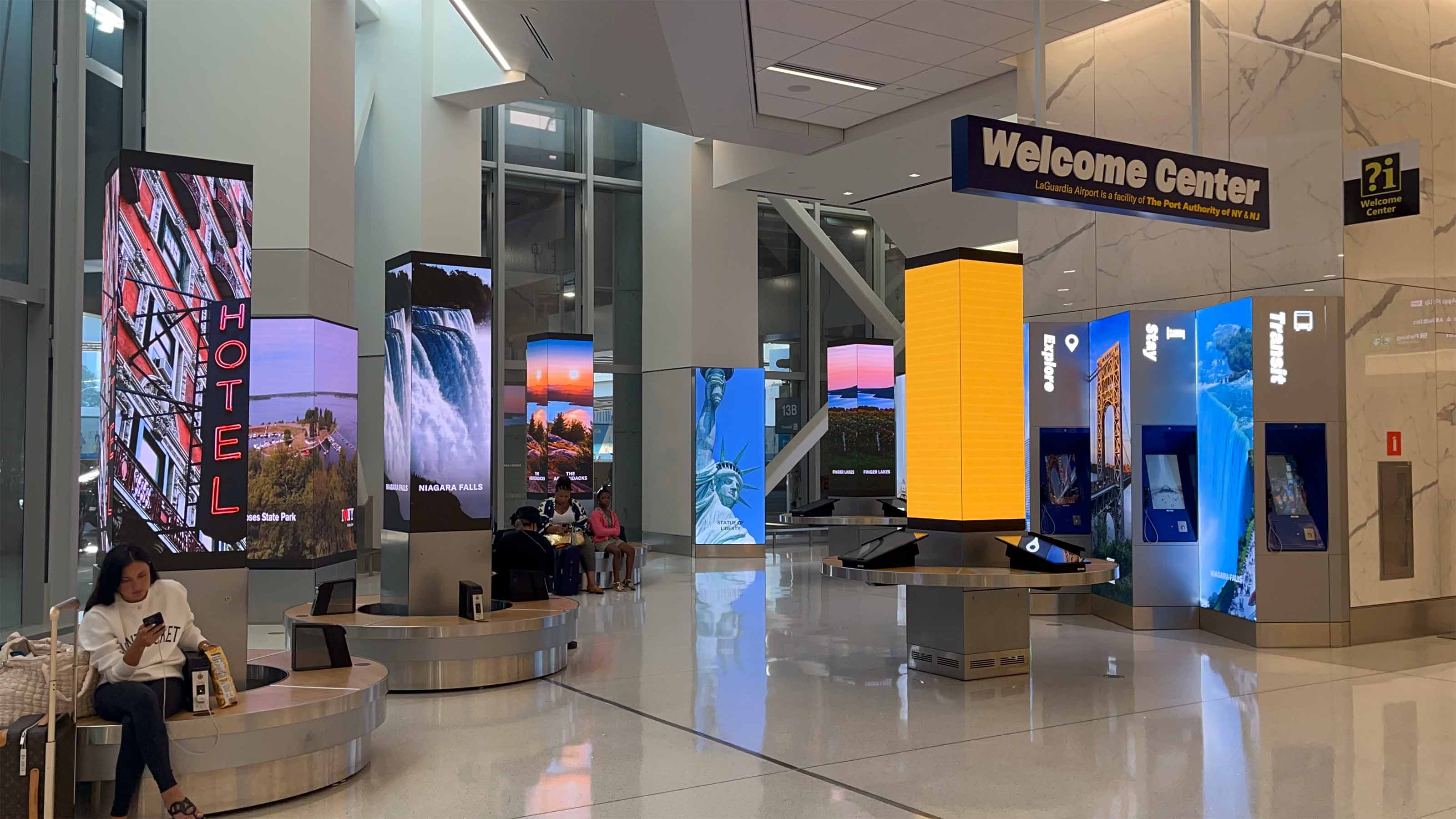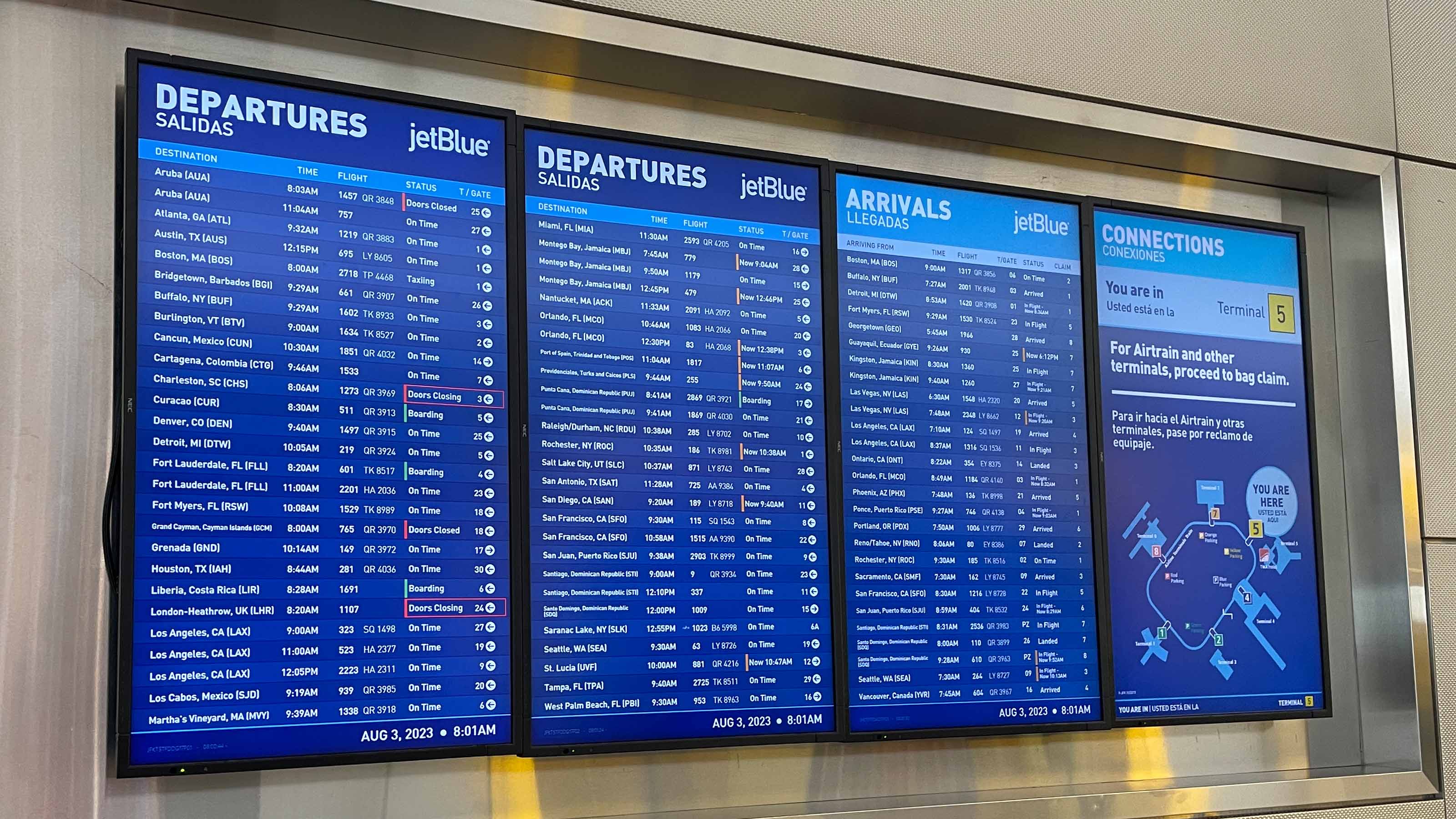How To Build a Better Airport
Unifying AV systems promises better experiences in the terminal.

Airport AV is complicated. The sheer amount of mission-critical communications required in this environment can lead to some intricate technology designs. But while the systems themselves may be complex, some argue that centralizing airport AV leads to a better experience for passengers, as well as the airport staff responsible for managing the audiovisual technology.
Ron Birkla is president of Red Envelope Consulting, a firm that provides design and consultation services to facility owners, manufacturers, and AV integration companies. An AV industry veteran, Birkla has spent much of his career designing systems for theme parks, casinos, and museums.

In 2022, he and his team began focusing on the transportation industry, including airport AV. One of the first things he noticed: Unlike the markets he was accustomed to working with—where audiovisual systems were operated, monitored, and managed from a centralized location—in airports, each AV system was designed to run on its own.
For example, there are approximately 8-10 AV subsystems in an airport environment. This usually includes passenger information displays, public address system, wayfinding, digital signage, concession AV, ADA compliance systems (such as assistive listening and visual paging), conference rooms, command-and-control center, and an emergency operations center. “In any other project—a casino or a theme park, for example—these systems would all be interconnected,” Birkla said.
Dangers of Disconnection
When AV systems are disconnected, any number of issues arise, especially in an airport, where passengers need easy access to critical flight information at all times. Birkla cited airport concessions as a prime problem area: “When John’s Sports Bar plays a game really loud, it conflicts with the passenger information from the PA in the concourse or adjacent gate,” he explained. “The bar turns up its audio, the airline requests audio at the gate to be louder to compensate, so the bar turns up its sound even more.” In the end, it’s all noise and passengers can’t hear important announcements.
[Editorial: Is Your Digital Signage as Good as DFW's Restroom?]
A daily selection of the top stories for AV integrators, resellers and consultants. Sign up below.
This is particularly problematic in an airport, since those they serve are, quite literally, from all over the world. Vlada Shchepynska, an experienced AV project coordinator and Ukraine native, cited herself as an example.

“I am not a native English speaker, and [in an English-speaking country] for me it would not be possible to understand what they’re talking about when the gates are so close together, and the sound from the bars, restaurants, and newsstands are conflicting with the paging system,” she offered. “I think that confusion is the biggest problem [in airports].”
Based on this, Birkla and his team began working with airport clients on what he calls a “unified approach” to AV. This model applies the same methodology the firm uses with its themed entertainment clients to simplify the airport’s AV ecosystem. “We look at every subsystem that touches AV and design a solution that unifies them into a single pane of glass for control and monitoring,” he said.
Concession audio, for example, is connected to and controlled by the facility-wide public address system. Birkla argued this not only prevents separate systems from competing against one another, but also "provides a slick solution for connecting assistive listening that can play back passenger info or IPTV in the concessions.” He said these relatively simple modifications significantly improve the passenger experience.
Opportunities and Challenges
For airport AV/IT staff, a unified approach to AV offers the convenience of remote monitoring and troubleshooting. According to Birkla, this enables staff—who are too busy to dispatch personnel to check up on equipment—quickly identify system failures, decreasing the number of unused (and useless) displays, speakers, paging stations, and amplifiers throughout the facility.
“We design an overarching monitoring system where they get automated reports of failures, whether it’s IPTV, paging, mass notification, or even conference room equipment or command and control centers,” Birkla explained. “When it comes back to a central station, it puts one person in a seat, in charge of monitoring and then dispatching service calls.”
“We look at every subsystem that touches AV and design a solution that unifies them into a single pane of glass for control and monitoring.”
There is also the opportunity for airports to generate added revenue by applying an AV-as-a-Service model to its concession clients. Concessions already lease internet and cable TV from airports; Birkla said services such as passenger information, public address, and assistive listening and visual paging services could be added to this package.
While a unified approach to airport AV may solve many problems, Birkla conceded that one of the main challenges with the model is the relationship between AV and IT. “The keystone technology that makes the unified AV solution possible is networking infrastructure,” he explained.
[What We Learned at the 2023 AV/IT Summit]
This means airport IT departments must be open to AV being on the network. “In transportation, that can be difficult because the AV systems might only be partially funded by IT—the budgets come from a wide variety of [departments] including operations, passenger experience, public relations, tenant relations, marketing, and the airlines themselves,” he noted. Getting all these different stakeholders to understand the benefits of this design model can be difficult.
Reducing Congestion
Radiant Technology Group, an AV design and integration firm headquartered in Lewis Center, OH, has been focused on building smarter airports since 2010, when the John Glen Columbus International Airport solicited the firm to centralize its digital signage management systems. Since then, the company has done work for the Minneapolis-St. Paul International Airport and several others, according to Doug Freutel, vice president and visionary.

Aside from simplifying digital signage management, Freutel explained that Radiant Technology is working with airports to limit congestion at key points, such as the gates where passengers wait to board their flights. He said part of this solution involves enhancing traditional flight boards that are positioned throughout amenity areas with regular updates on things like gate changes or passenger alerts. Wayfinding and public information screens may also display data on wait times in nearby restaurants, or occupancy levels in the restrooms—important information that helps passengers plan their time at the airport.

Freutel also noted that Radiant recently worked with Omnivex, a digital signage content management software developer based in Concord, Ontario, to enhance the mobile passenger experience. By scanning a QR code at their gate, passengers may receive up-to-the-minute information about their flight as they are visiting other areas of the airport.
“The challenge with flight apps is there can be a delay of as long as 20 minutes between [the information they deliver] and what’s actually showing at the gate,” he said. “You may be at the Sky Lounge with your [flight app] up and it’s showing, ‘my flight’s taking off in 20 minutes, I’d better get to my gate.’ When you get to the gate, you find out your flight’s been delayed an hour.”
[Louisville Muhammad Ali Airport Strives to Be ‘The Greatest’ with AtlasIED]
By delivering actual gate data, Freutel said airports can decrease the congestion that often manifests around boarding areas. This same information is also translated into text messaging that can be delivered to the displays positioned throughout the airport for ADA compliance. "We’re really looking at how to use digital signage to optimize flow throughout the airport to make people feel more comfortable, take advantage of the amenities at the airport, and feel less tethered to the actual gates,” he added.
A Better Experience

Ryan Biziorek, associate principal and acoustics and audiovisual expert at Arup, a global sustainable development consultancy, noted that airlines themselves are paying increasing attention to customer experience from the moment passengers purchase a ticket, all the way through to the conclusion of their trip.
“The hospitality experience is end-to-end, [and] the airport terminal has really become a hospitality experience,” he offered. “With that, we’re seeing more investment in audiovisual technologies integrated in the architecture to create this experience.” These experiences may come in the form of large LED video wall systems for digital art, design elements that convey the fabric of the community in which the airport is located, or even performance spaces, theaters, or small museums sponsored by local institutions.
[Realmotion Delivers Immersive, 'Selfie-Ready' Experience at Orlando Airport]
For Shchepynska, providing a great passenger experience is essential if airports—and airlines—want people to have a positive opinion of their brands. “People tend to remember bad experiences, and even if my trip was absolutely perfect but I had a bad experience in the airport, I will remember it and I will tell everybody about it,” she said. “It is really important for passengers to have a good experience.”
Better Acoustics = Better Airport
Ryan Biziorek, associate principal at Arup, noted that one of the primary challenges in communicating an acoustic design to clients is that acoustics aren’t something that one can see, touch, or feel. For this reason, Arup consultants invite clients to the company’s Sound Lab, a virtual listening space that recreates acoustic environments in three dimensions.
“You can think of it like a visual rendering but for sound, which we call an auralization,” Biziorek explained.
This enables clients to experience and evaluate different acoustic scenarios based on a facility’s architecture, use case, and how things like occupancy levels affect sound. Arup recently applied this approach to the Portland International Airport in Oregon, as part of its Terminal Core Redevelopment project.
“We were looking at the passenger journey and simulating how that was going to sound, with different design options from right when you got to drop-off all the way through up to your boarding gate,” Biziorek said.
Carolyn Heinze has covered everything from AV/IT and business to cowboys and cowgirls ... and the horses they love. She was the Paris contributing editor for the pan-European site Running in Heels, providing news and views on fashion, culture, and the arts for her column, “France in Your Pants.” She has also contributed critiques of foreign cinema and French politics for the politico-literary site, The New Vulgate.
